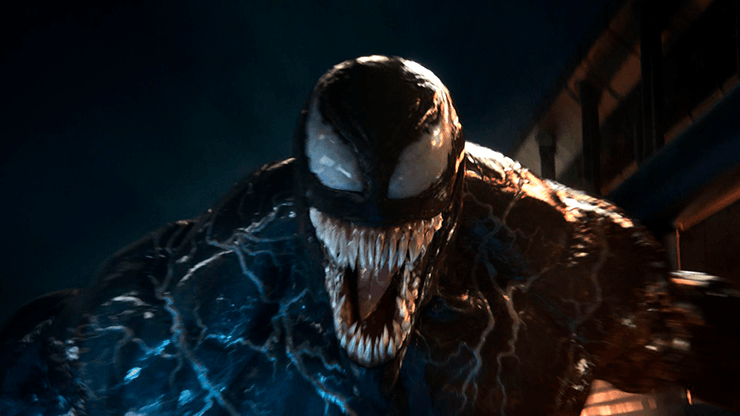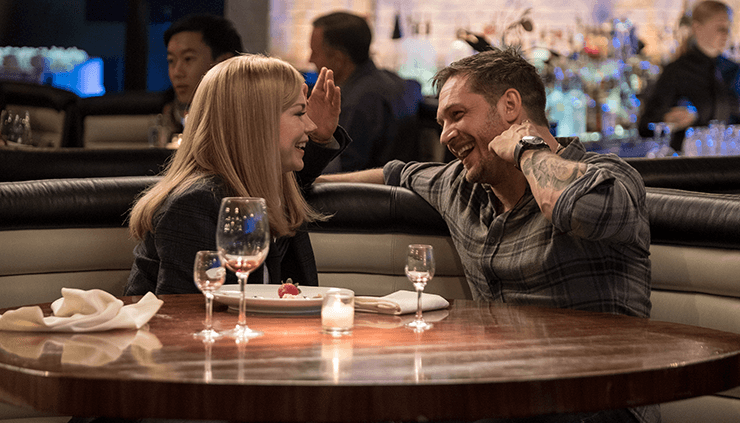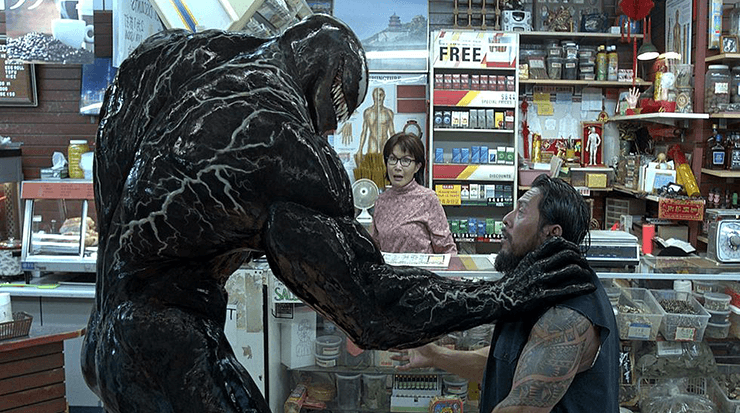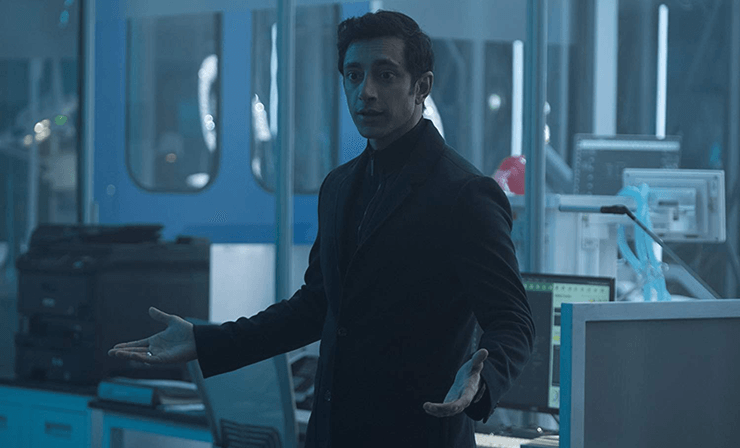As is often the case in superhero movies these days, especially ones featuring Marvel’s heroes, Venom has both a mid-credits scene and an end-credits scene. The former sets up a potential sequel in a manner that manages to be both inevitable and confusing, while the latter is, of all things, a clip from Spider-Man: Into the Spider-Verse, the forthcoming animated film starring several different versions of Spider-Man.
The latter is notable because it’s by far the most enjoyable thing in Venom. Which is kind of a problem, as it’s from a completely different movie.
Venom is completely divorced from any mention of Spider-Man. There are elements of the Spider-mythos present (my favorite Easter egg is a text message from Barney Bushkin, the editor-in-chief of the Daily Globe), but Spidey himself isn’t involved. And this is kind of a problem, since the whole point of Venom is that he’s a counter to Spider-Man.
Venom was created in 1988, but it started four years earlier in the Secret Wars miniseries, in which Spidey got a new black costume. He kept that look for a few years, later alternating between the black costume and his traditional red-and-blue. But then the original black costume, which had been revealed as an alien symbiote, bonded with a disgraced journalist named Eddie Brock, and Venom was born. A big part of the character’s appeal was in how he related to Spider-Man: the symbiote was pissed at Spidey for rejecting him, and Brock was pissed at the hero because he was involved (indirectly) in his disgrace. (In my recent rewatch of Spider-Man 3, I spelled out the whole thing in gory detail if you’re interested.)
As time went on, Venom became hugely popular, necessitating a move to San Francisco and a reimagining as the “lethal protector of the innocent” in order to justify keeping him around as the hero of a title (the 3000-mile move also getting him off Spider-Man’s radar).
The new movie Venom hits pretty much every one of those beats, but removed from the context of the connection to Spider-Man. The white spider is no longer seen on Venom’s chest, but the eyes are still the same for no compellingly good reason except character recognition. Brock’s backstory is similar in that he was a journalist for the Daily Globe in New York, was disgraced, and moved to San Francisco to become a broadcast journalist of a sort (he’s supposedly on a television network, but he appears to be streaming online; it’s not very clear, and the script doesn’t seem interested in explaining it). He’s engaged to Ann Weying, a lawyer, just like the comics, and he does something unethical that gets him fired and costs him his relationship with Weying, just like the comics. And Brock bonds with an alien creature, just like the comics, eventually winding up a kind of anti-hero.
Venom is one of many symbiotes, a handful of which are brought back from space by the Elon Musk-esque Carlton Drake. Drake believes humanity’s future is off Earth, and he thinks these symbiotes can bond with humans and enable them to live in space. (The symbiotes themselves can’t survive without a host in Earth’s atmosphere.) Drake keeps this scientific find to himself because he wouldn’t be much of an evil scientist if he didn’t jump straight to human trials and kill off lots of homeless people testing it out.
Brock was disgraced because of an interview with Drake. Told by his boss to just ask about his next spaceship (the one with the symbiotes crashed in Malasyia), Brock instead snoops on Weying’s computer to find out about the wrongful death suit against Drake’s company and then asks him about it in the interview. This gets both Brock and Weying fired. (Remember kids, don’t snoop on your significant other’s password-protected laptop. It won’t end well.) When a member of Drake’s staff tells Brock about the homeless people being sacrificed on the altar of symbiote-testing, Brock agrees to be smuggled in, and he winds up bonding with one of the symbiotes.
The only change this movie made from the four-color source material that I liked was that the script leans into Venom’s oft-stated threat in the comics of wanting to eat people’s brains. In the movie, the symbiotes need to eat live meat in order to survive—if not, they start to consume the organs of their hosts. (This strikes me as biologically stupid, but whatever.)
Eventually, the leader of the symbiotes, named Riot, finds its way from the crash site in Malaysia to Drake, bonds with Drake, and eventually sets up his new spaceship to take him to bring more symbiotes to Earth so they can take over and consume the planet. Venom rebels against Riot because the script says he does, there’s a big fight, and Venom blows up the rocket with Drake/Riot in it.
One of the most unconvincing things Marvel did was try to turn Venom into a type of hero. The whole “lethal protector of innocents” shtick they developed for the Venom: Lethal Protector miniseries was done to enable them to continue to do Venom stories (the character was unimaginably popular in the 1990s) without it always being Spider-Man fighting Venom.
You’d think that untying Venom from Spider-Man would free them to do a better job of it in the movie, but it’s actually less convincing here because we’re given absolutely no reason why Venom turns against Riot. At one point Venom calls Brock a loser, and then later he admits that, by symbiote standards, he’s a loser, too, and—er, well, that’s it.
Being convinced that Brock is a loser is easy because, well, he is. The only reason this movie is in any way watchable is because Tom Hardy sells the notion of Brock as this schlubby fuckup. He has just enough charm that you believe that people are willing to talk to him (the only manner in which he’s believable as a journalist is his easy ability to chat with folks and put them at ease), and he’s obviously having fun with the Gollum/Smeagol style conversations with the symbiote.
Unfortunately, half the time it feels like he’s acting in a different movie from everyone else. The plot is depressingly tired, hitting all the usual beats without anything to make it interesting. Riz Ahmed has absolutely zero charisma as Drake, his blank affect making him seem way more like a sociopath than his alleged public persona should allow. As an example, he talks to one of his homeless victims to put him at ease before he’s bonded with the symbiote, but the talk doesn’t work because he’s too flat and monotone while delivering it. Ditto for his confrontation with Dr. Skirth, Jenny Slate’s whistleblowing scientist. Skirth practically has a sign with the words “DEAD MEAT” on her forehead, as you count the microseconds until Drake kills her for her sudden but inevitable betrayal. The actual death is so predictable that every viewer in the audience predicted it about an hour before it happened, rendering the death itself perfunctory.
Everything that happens in this movie does so because the script calls for it, not because it’s in any way justified by the characters or the events. Drake sends his goon squad and drones after Brock so we can have a chase through the streets of San Francisco, but the whole notion makes no sense. Drake’s employees barrel through the streets, blowing up other people’s cars, using drones that you know are Drake’s proprietary tech, damaging property, all in the midst of a large city that’s full of traffic cameras. The San Francisco Police Department should have been all over Drake’s ass from that point in the movie onward, especially given how much evidence Drake left lying around so the movie could have a chase scene, but the cops are only seen to clean up the mess.
And that’s just the beginning. Supposedly the symbiotes can’t survive in Earth’s atmosphere without a host, yet Venom buggers around through the hospital after Weying separates him from Brock for quite a while. If the symbiote knows everything the host knows, why does Venom have to ask Brock who Weying is? Why doesn’t Drake tell the world that he’s found alien life, which would only improve his public profile as a heroic figure? Why did the Riot symbiote walk away from the crash if he was just going to travel to Drake’s headquarters (where the other symbiotes were taken) anyhow? Once Riot bonded with Drake, why did he dick around with questioning Brock and all that other stuff, why not just go straight to the part where he flies in the rocket ship to retrieve his fellow symbiotes, which, if nothing else, would preclude Venom interfering in the launch?
That interference provides us with a final fight scene that is a particularly boring and incomprehensible CGI-drenched climax even by the appallingly low standards of boring and incomprehensible CGI-drenched climactic fight scenes that we’ve gotten in superhero movies the past two decades. Riot and Venom look too much alike—the former is silver, the latter black—that you can’t tell them apart in the fight. Riot should have been given a more distinct color, like green or yellow or something.
Tonally, the movie is all over the place. Sometimes it’s horror, sometimes it’s science fiction adventure, sometimes it’s black comedy. It really needed more of the latter, because by far the best moments of the movie are the ones that embrace the dark humor. (Probably the biggest laugh of the entire movie is when Venom calls Brock a pussy after Brock refuses to follow the symbiote’s urging to jump out a high-story window.)
Once you get past Hardy, who’s at least having fun with it, the performances are pretty nowhere. Poor Michelle Williams does the best she can with Weying, and the character does have several shining moments when she saves Brock’s ass (including one bit where she, like her comics counterpart, becomes “She-Venom“), but it’s mostly a thankless plot-device-y part, like far too many female roles in action films. Scott Haze has all the menace of a cardboard cutout as Drake’s security chief, Reid Scott has all the charm of a dead lobster as Weying’s new doctor boyfriend (an even more thankless and plot-device-y role than Weying, which is impressive, I guess), and Slate has all the personality of a high-school drama student as Skirth. Some of the smaller roles are at least charming, from Michelle Lee’s homeless friend of Brock’s who becomes one of Drake’s experiments, to Emilio Rivera’s security guard, to Ron Cephas Jones’s relaxed and hip portrayal of Brock’s boss, to Peggy Lu’s deli owner, to the inevitable Stan Lee cameo as a dude walking his dog.
The film’s producers have said in interviews that they viewed doing Venom without Spider-Man as a challenge, which is absolutely the right attitude for people creating a story to take under the circumstances. Sadly, the lack of Spidey proves instead to be more of a warning. They’d have been better off moving farther away from the Spider-connections and telling a new story instead of hitting all the beats of Venom’s origin without the arachnid context. Or at the very least settled on a tone. Had they gone full Deadpool and let Hardy just go batshit, the movie would be a lot more fun. The tagline for this movie is that there are enough superhero movies, but that promises something different with Venom, and it so totally isn’t. It’s the same story as every other superhero origin movie with the only difference that the title character will sometimes bite off the bad guy’s head. It’s not enough, even though it really should be.
And finally, if you’re going to tease the next movie as featuring Venom facing Carnage, you need to give us a little bit more than Woody Harrelson in a bad wig. Half the theatre I saw Venom with had no idea who Harrelson was supposed to be. (I knew he was Cletus Kassady, the serial killer who, in the comics, bonded with a seed of the Venom symbiote to become Carnage, but the mid-credits scene didn’t do enough to establish any of that, not even mentioning Kassady’s name.)
Doing a Spider-Man-free Venom film was always going to be a tall order. This is one you should have the waiter send back.
Keith R.A. DeCandido‘s first short story and first novel both were collaborative Spider-Man tales featuring Venom: the 1994 short story “An Evening in the Bronx with Venom” in The Ultimate Spider-Man, written with John Gregory Betancourt, and the 1998 novel Venom’s Wrath, written with José R. Nieto. He currently writes “4-Color to 35-Millimeter: The Great Superhero Movie Rewatch” every Friday here on Tor.com, looking at every live-action movie based on a superhero comic book. See him this weekend at the Creatures, Crimes, and Creativity Conference in Columbia, Maryland, support his Kickstarter for the short story “The Fall of Iaron,” and check out his other work on this site covering Star Trek, Batman, Doctor Who, Marvel’s Netflix series, Stargate, and more.














